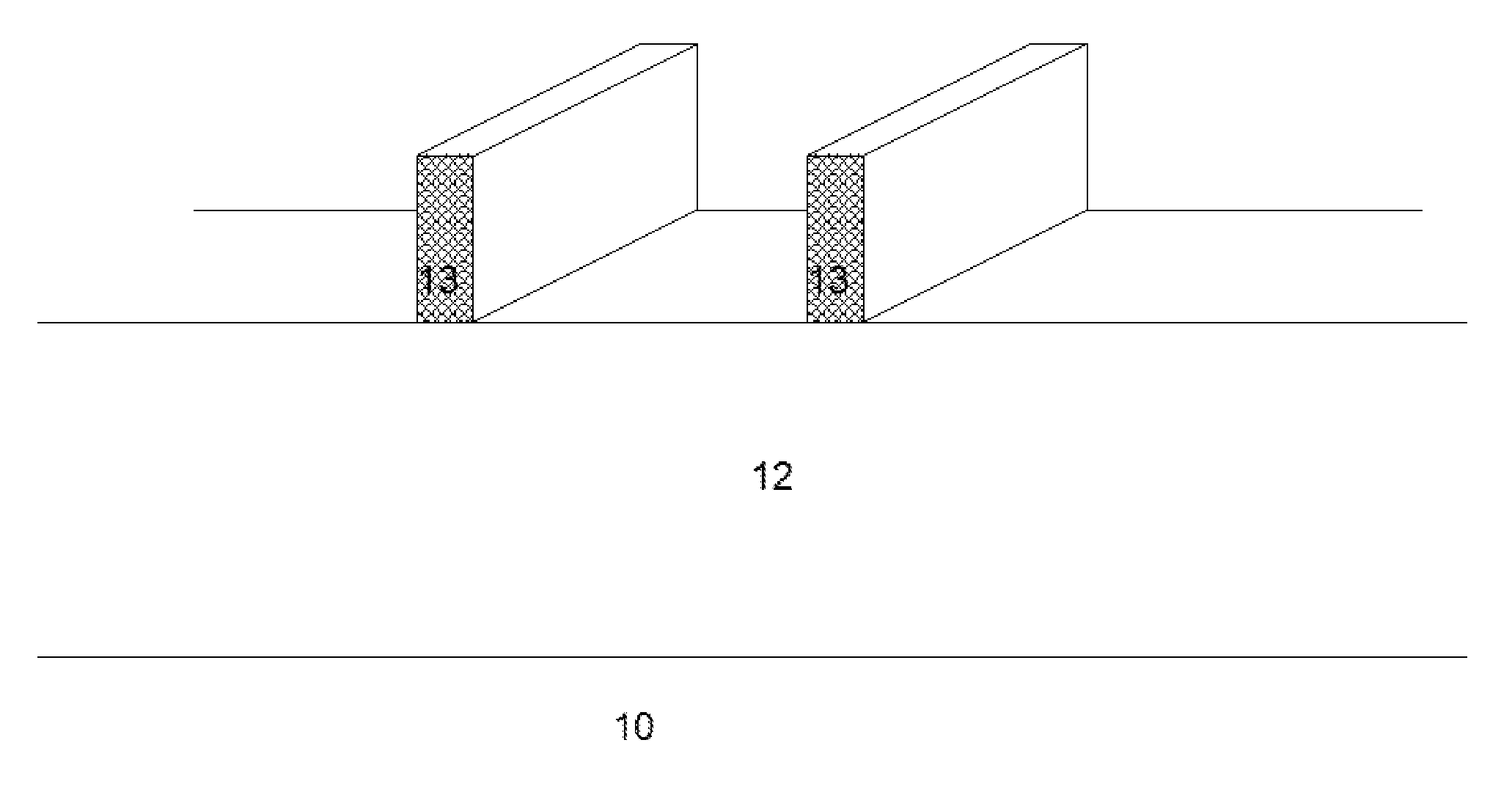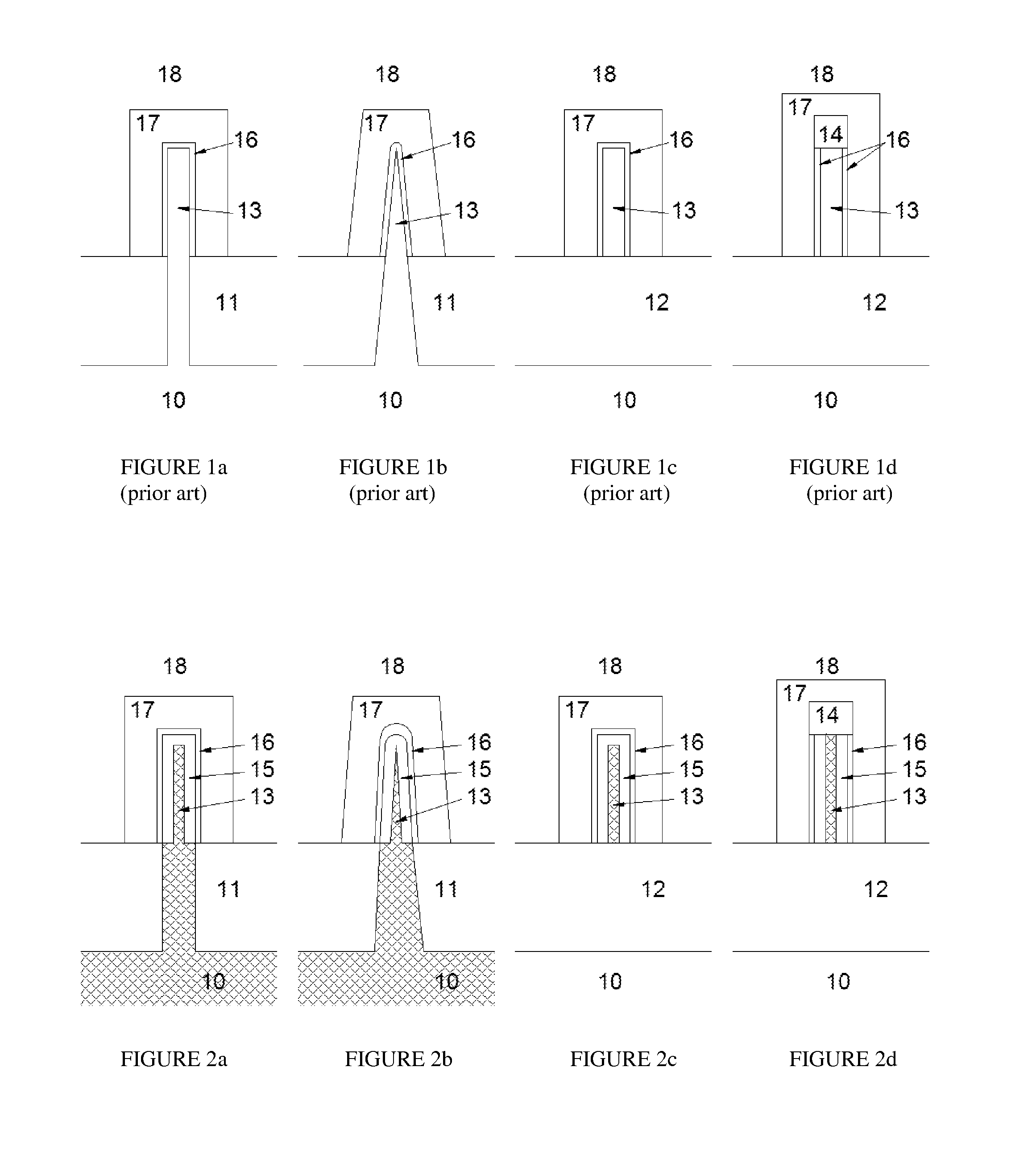Random Doping Fluctuation Resistant FinFET
a technology of metal oxides and transistors, applied in the direction of basic electric elements, electrical apparatus, semiconductor devices, etc., can solve the problems of uncertainty due to the variation in the number of dopant atoms, and the problem of nsup>1/2 /sup> comes to the for
- Summary
- Abstract
- Description
- Claims
- Application Information
AI Technical Summary
Benefits of technology
Problems solved by technology
Method used
Image
Examples
exemplary embodiment 1
[0027]In a first exemplary and non-limiting embodiment the configuration is similar to FIG. 3, with a substrate 10 and a buried oxide 12. The fins 13 as shown in FIG. 4a are processed from the fins in FIG. 3, but rather than being lightly doped, less than 1017 / cm3 as in prior art low fluctuation transistors, they are highly doped by intention, and they will become cores for the final fins. The high doping the cores of these fins adjusts the threshold voltage of the fins to a desired high value. The fin cores are 5 nm to 15 nm thick, typically 10 nm, and they are doped with donors (for a PMOS device) or acceptors (for an NMOS device) to a density of 1018 / cm3 to 1020 / cm3. Alternatively, the highly doped fins in FIG. 4a may be formed from a highly doped layer, meaning that the heavy doping occurs before the fins are etched. For SOI fins, doping first is probably more convenient. After forming the highly doped fin cores 13, an undoped or lightly doped layer 15 of epitaxial silicon, sili...
exemplary embodiment 2
[0030]In the second exemplary and non-limiting embodiment the fins are formed from the substrate 10, as illustrated in exemplary and non-limiting FIG. 5a. The isolation oxide 11 between the fins provides a platform upon which the transistors are formed. The fins 13 in FIG. 5a are highly doped by intention to become cores for the final fins. The fin cores 13 are 5 nm to 15 nm thick, typically 10 nm, and they are doped with donors (for a PMOS device) or acceptors (for an NMOS device) to a density of 1018 / cm3 to 1020 / cm3. This doping can be done either before or after the fin cores are formed. After forming the highly doped fin cores 13, the fins are expanded by growing an undoped or lightly doped layer 15 of epitaxial silicon, silicon-germanium or other semiconductor as a sheath over the highly doped core. This is shown in exemplary and non-limiting FIG. 5b. The undoped epitaxial layer has a typical final thickness in the range of 5 nm to 15 nm, and it should be grown at a low tempera...
exemplary embodiment 3
[0032]In the third exemplary and non-limiting embodiment the initial fins 131 are also formed from the substrate 10, as illustrated in FIG. 6a. Between the initial fins 131 the isolation oxide 11 provides a platform upon which the transistors are formed. The initial fins 131 in FIG. 6a are highly doped by intention, but they are wider than the fin cores 13 in Embodiment 2 as they are subject to additional processing. The initial fins 131 are 15 nm to 50 nm thick, typically 30 nm, and they are doped with donors (for a PMOS device) or acceptors (for an NMOS device) to a density of 1018 / cm3 to 1020 / cm3. The doping in the fins is determined by the desired threshold voltage. This doping can be done either before or after the initial fins are formed. The next step, shown in exemplary and non-limiting FIG. 6b, is an etching step that removes a portion of the initial fins 131 to leave fin cores 13, which are typically 5 nm to 15 nm wide. After the etching step leaves the highly doped fin co...
PUM
 Login to View More
Login to View More Abstract
Description
Claims
Application Information
 Login to View More
Login to View More - R&D
- Intellectual Property
- Life Sciences
- Materials
- Tech Scout
- Unparalleled Data Quality
- Higher Quality Content
- 60% Fewer Hallucinations
Browse by: Latest US Patents, China's latest patents, Technical Efficacy Thesaurus, Application Domain, Technology Topic, Popular Technical Reports.
© 2025 PatSnap. All rights reserved.Legal|Privacy policy|Modern Slavery Act Transparency Statement|Sitemap|About US| Contact US: help@patsnap.com



